This red maple is going to be entering it's fourth grow season of its life. It started out as a 'weed' in this very fabric grow pot that housed a tomato plant. Then I left it in there the second year without repotting to let it get vigorous. the third year, I repotted it in some very mid substrate for some reason, idk why. it was mostly boon soil scrap mixed with coarse perlite and some crappy topsoil, for some reason. I planted this on top of some random plastic drain tray for a succulent pot as a quick and dirty ebihara method and it worked quite well. Some wire bite from last year means this wont be a beauty queen most likely unless it gets really thick and barky. I may end up just cutting right above that first low branch and using that as my new leader to develop the tree, that way the scarring is very limited even though it means a setback of like 2 years.
I'm repotting it from a 5gal pot to a 3gal, and using a 70/30 mix (roughly) of small perlite/coco coir. This gives me a very moist but airy substrate, and combined with the extra moisture retained by the fabric pot, creates a growing environment that is very wet but has access to as much oxygen as needed. I've found that my other red maples (which were also in 5gal fabric pots, no plastic tray, substrate of 70/30 coarse perlite+compost) respond very well to these conditions. the smaller particle size will encourage finer roots, and will be even wetter. These maples are native to my area of new york which is very wet, so I theorize these that my new substrate will push even more growth.
You can see the crappy soil in pics 2 and 3.
pic 4:: escape roots from last year's growth
pic 5, 6: after shaking the tree upside down to get all loose soil out, you can see how the roots are air pruned very radially. air pruning encourages feeder roots to grow and shows that even with my crappy soil, we still get zero root rot and vigorous growth
pic 7 bottom of the pot after tree removal. minimal root circling as most found their way through the fabric
pic 8, 9, 10: after knocking soil out some more, you can see the tray I planted it on. pretty much no root growth in the center, I'd need a few growing seasons to achieve that.
pic 11. 12, 13: cleaning off the roots after cutting off everything that was vertical. pretty convenient to grow this way, makes it quick to get to the actual important work. you can see how well the plastic tray worked to encourage radial rooting, but the ebihara method is always prone to crossing roots.
pic 14: radical root cutback. this was about what I cut back to last growing season when I initially planted it on the tray. even with crappy substrate, the fabric pot + ebihara method produces very quick results. the roots werent anywhere close to as nebari-like last year.
pic 15, 16: potted back up. I didn't show it, but I always put a spagnum top dressing or a layer of extra large perlite on top. the small perlite is easily pushed by your watering, and perlite in general is extremely light so it has trouble stabilizing a tree. combined with a fabric grow pot, you dont have much in the way of support. I've found the spagnum top dressing holds everything very firm until the tree can establish and stabilize itself. coarse perlite can achieve similar things by creating a reverse drainage layer,, allowing the water to gently flow down onto the small perlite instead of everything getting pushed around.
will post next year's growth, quite happy with these fabric grow pots for early prebonsai development. I'm using a mix of 1 and 3 gallon for my prebonsai currently. the major downside to these pots is you cant wire your trees down to them,, the most you can do is use some plant on the rim of the bag but the fabric makes true stabilization quite hard. but I've found that if you plant deeper and be careful, it's really no problem. hopefully this inspires some of you to try a fabric grow pot!
I'm repotting it from a 5gal pot to a 3gal, and using a 70/30 mix (roughly) of small perlite/coco coir. This gives me a very moist but airy substrate, and combined with the extra moisture retained by the fabric pot, creates a growing environment that is very wet but has access to as much oxygen as needed. I've found that my other red maples (which were also in 5gal fabric pots, no plastic tray, substrate of 70/30 coarse perlite+compost) respond very well to these conditions. the smaller particle size will encourage finer roots, and will be even wetter. These maples are native to my area of new york which is very wet, so I theorize these that my new substrate will push even more growth.
You can see the crappy soil in pics 2 and 3.
pic 4:: escape roots from last year's growth
pic 5, 6: after shaking the tree upside down to get all loose soil out, you can see how the roots are air pruned very radially. air pruning encourages feeder roots to grow and shows that even with my crappy soil, we still get zero root rot and vigorous growth
pic 7 bottom of the pot after tree removal. minimal root circling as most found their way through the fabric
pic 8, 9, 10: after knocking soil out some more, you can see the tray I planted it on. pretty much no root growth in the center, I'd need a few growing seasons to achieve that.
pic 11. 12, 13: cleaning off the roots after cutting off everything that was vertical. pretty convenient to grow this way, makes it quick to get to the actual important work. you can see how well the plastic tray worked to encourage radial rooting, but the ebihara method is always prone to crossing roots.
pic 14: radical root cutback. this was about what I cut back to last growing season when I initially planted it on the tray. even with crappy substrate, the fabric pot + ebihara method produces very quick results. the roots werent anywhere close to as nebari-like last year.
pic 15, 16: potted back up. I didn't show it, but I always put a spagnum top dressing or a layer of extra large perlite on top. the small perlite is easily pushed by your watering, and perlite in general is extremely light so it has trouble stabilizing a tree. combined with a fabric grow pot, you dont have much in the way of support. I've found the spagnum top dressing holds everything very firm until the tree can establish and stabilize itself. coarse perlite can achieve similar things by creating a reverse drainage layer,, allowing the water to gently flow down onto the small perlite instead of everything getting pushed around.
will post next year's growth, quite happy with these fabric grow pots for early prebonsai development. I'm using a mix of 1 and 3 gallon for my prebonsai currently. the major downside to these pots is you cant wire your trees down to them,, the most you can do is use some plant on the rim of the bag but the fabric makes true stabilization quite hard. but I've found that if you plant deeper and be careful, it's really no problem. hopefully this inspires some of you to try a fabric grow pot!
Attachments
-
 1 - XPIVjFA.jpg359.4 KB · Views: 144
1 - XPIVjFA.jpg359.4 KB · Views: 144 -
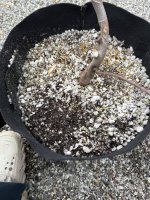 2 - 7H59TJm.jpg363 KB · Views: 111
2 - 7H59TJm.jpg363 KB · Views: 111 -
 3 - FPtHrh3.jpg474.6 KB · Views: 82
3 - FPtHrh3.jpg474.6 KB · Views: 82 -
 4 - v5IGY6s.jpg217.5 KB · Views: 79
4 - v5IGY6s.jpg217.5 KB · Views: 79 -
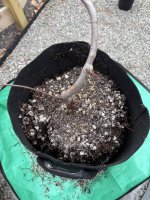 5 - mxJQ8Td.jpg301.4 KB · Views: 78
5 - mxJQ8Td.jpg301.4 KB · Views: 78 -
 6 - NBVwrlr.jpg298.7 KB · Views: 80
6 - NBVwrlr.jpg298.7 KB · Views: 80 -
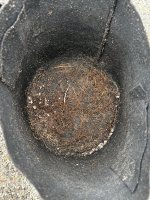 7 - SJjW2XR.jpg362.1 KB · Views: 82
7 - SJjW2XR.jpg362.1 KB · Views: 82 -
 8 - Q0I6sGA.jpg369.7 KB · Views: 83
8 - Q0I6sGA.jpg369.7 KB · Views: 83 -
 9 - Q7A5yAb.jpg354.8 KB · Views: 79
9 - Q7A5yAb.jpg354.8 KB · Views: 79 -
 10 - jzqzXpv.jpg367.5 KB · Views: 85
10 - jzqzXpv.jpg367.5 KB · Views: 85 -
 11 - rw2kC5f.jpg309.4 KB · Views: 97
11 - rw2kC5f.jpg309.4 KB · Views: 97 -
 12 - XHy59yY.jpg263.9 KB · Views: 112
12 - XHy59yY.jpg263.9 KB · Views: 112 -
 13 - Fvw4nYY.jpg364.4 KB · Views: 113
13 - Fvw4nYY.jpg364.4 KB · Views: 113 -
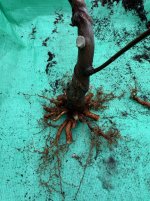 14 - mUJe3Eu.jpg400.8 KB · Views: 116
14 - mUJe3Eu.jpg400.8 KB · Views: 116 -
 15 - bE6l9TR.jpg272.5 KB · Views: 126
15 - bE6l9TR.jpg272.5 KB · Views: 126 -
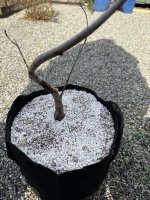 16 - 6pnCF9U.jpg293.2 KB · Views: 152
16 - 6pnCF9U.jpg293.2 KB · Views: 152
